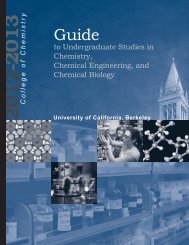Newsjournal body.qxp - College of Chemistry - University of ...
Newsjournal body.qxp - College of Chemistry - University of ...
Newsjournal body.qxp - College of Chemistry - University of ...
You also want an ePaper? Increase the reach of your titles
YUMPU automatically turns print PDFs into web optimized ePapers that Google loves.
SPIKY. One <strong>of</strong> the ferromagnetic fluids synthesized in Chem 108. The liquid spikes<br />
come from effects <strong>of</strong> a nearby magnetic field on the magnetic particles<br />
suspended in a liquid.<br />
Both types <strong>of</strong> materials were chosen because <strong>of</strong> current interest in their<br />
potential applications, and because, according to Arnold, “it allows the students<br />
to have the experience <strong>of</strong> making a compound which is useful.”<br />
Neither compound has been studied previously in Chem 108.<br />
“Each year we try to do something new to rejuvenate the course,” continued<br />
Arnold. “This year we added a theory component, so students did calculations<br />
to understand the structure and bonding <strong>of</strong> the compounds. We also<br />
expanded upon the materials chemistry.”<br />
During the final class period, students present their results in a poster<br />
session. The best projects will likely be included in next year’s laboratory<br />
manual. Thus the course is always changing, and the material stays fresh<br />
and exciting.<br />
It is clear that all involved parties enjoyed the experience. The pr<strong>of</strong>essors<br />
welcome the chance to work closely with the students. “It is one <strong>of</strong> the few<br />
courses in the department where you have a high degree <strong>of</strong> interaction with<br />
the undergraduate students. You get to know them very well,” noted<br />
Arnold.<br />
The students agreed. Kaori Kitano, a fourth-year chemistry major who<br />
took the course last fall, liked working in a small group and collaborating<br />
with classmates. Another student, Blueray Curtis, added, “I think the<br />
GLOW IN THE DARK. The students in Chem 108 prepared compounds<br />
used to make light emitting diodes. Found in traffic lights and displays for<br />
electronic devices, these compounds have the special property <strong>of</strong> emitting light<br />
when a current passes through them.<br />
independent projects are an excellent idea and my favorite thing that I’ve<br />
done in four years. I strongly prefer a course with more independent<br />
projects and fewer assigned labs.”<br />
In fact, the students would have liked to spend even more time experimenting<br />
in the lab and perfecting their poster presentations. The graduate<br />
research instructor, Stephen Kaye, noticed the students’ enthusiasm and<br />
was impressed with their efforts. “They certainly worked really hard,” he<br />
remarked.<br />
An ultimate goal for the future is to publish one <strong>of</strong> the projects in the<br />
Journal <strong>of</strong> Chemical Education, an American Chemical Society journal that<br />
keeps educators updated with the latest innovations in research and teaching<br />
methods. This hasn’t been tried yet, and would require a student to<br />
work beyond the end <strong>of</strong> the semester. It could be a challenge for upper<br />
division students to find time to commit to such a project, but it is hoped<br />
someone will tackle it soon.<br />
. . . . . . . . . . . . . . .<br />
“I think the independent projects are an excellent idea and my favorite thing that I’ve done in four years.”<br />
. . . . . . . . . . . . . . . . . . . . . . . . . . . . . . . . . . . . . . . . . . . . . . . . . . . . . . . .NEWSJOURNAL 2005<br />
all courtesy John Arnold<br />
21




